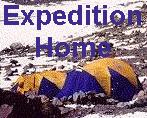 Preparations.
Preparations.
Here are excerpts from our slide picture show. Unfortunately, we have no summit picture, or shots of the Canelita or Refugio Independencia, as the weather turned us around at 6200 meters. However, this is a unique collection in that it includes photos of both the Vacas/Relinchos/Polish Glacier (our ascent route) and Ruta Normal/Horcones/Plaza de Mulas (our descent route). So you get to see both in one place, in spite of the fact we lost several rolls of film at Camp II! .For other collections of Aconcagua climbing pictures on the net, check out our page of Aconcagua links.
Click on any of the pictures for a larger version of the ones you'd like to study, then use your browser's "back arrow" to return to this page.
No, that's not Aconcagua! The team took several weekend climbs together, to get to know each other's climbing styles, test out equipment, check our conditioning programs, and enjoy the views. This was our camp below McClure Rock on Mount Rainier, about 7200 ft. On our two snowshoe climbs to this spot we headed up in fog and snow, with one to two feet of new snow on the ground, and on both trips we woke up with another 8-12 inches of fresh snow. The difference was the first trip it was still snowing and foggy Sunday morning when we headed back down, but this is the view Sunday morning of the January trip. These are the sights that keep bringing us back!
The team at our departure from Seatac Airport. Left to right Rob B, Lisa M, Roy O, Rik A, Bill L. All five of us are wearing the expedition t-shirts. We started with 144 of these, and sold all but a few of them. About twenty friends and relatives came out to see us off. Our itenerary took us through Dallas to Santiago, where we spend one night before heading for Argentina.
Rob and Rik, with the obligatory shot next to the sign on the highway between Las Cuevas and Puenta del Inca, the one place where the mountain can be seen from the Trans-American highway.
Sunset on Aconcagua, from the second approach camp at Casa Piedra ("Stone House") near the junction of the Vacas and Relinchos rivers. The Polish Glacier can be seen flowing down the northeast face of the mountain. The mountain was making its own weather for much of our climb, as here where the south face is obscured by clouds.
Plaza Argentina, at 13,700 feet, is the dropping off point for mule loads. In this shot, taken on our rest day here, Cerro Ameghino, ca. 6000 meters, stands above the camp freshly dusted with snow from the previous day when we moved up from Casa Piedra.
Guardeparke (Ranger) Ariel (center) meets with the OSAT team (Rob, Lisa, Rik, and Bill) at our Plaza Argentina Camp during our rest day. By this time we figured muleteers had spread the word over the entire mountain about "la roja senorita", our red-headed and re-outfitted team member. Everywhere we went the rangers, muleteers, and other climbers took notice of Lisa.
On our carry day from Plaza Argentina to Camp I (16,000 ft), we pause at the base of the East Glacier. Although clear most of the day, the wind was strong enough to knock us off our feet this day, and we were glad to stash our loads and return down to Plaza Argentina.
Rik on the carry to Camp I. The last 300 meters of vertical to Camp I is particularly challenging, with a steady steep slope. This was so our first view of the Penitentes, two to four foot ice pinnacles that form as what we know in the northwest as suncups run amok in the high Andes sun.
The next day we moved up to Camp I in snow, cold, and wind. Here we are on the final slope below Camp I. Setting up camp that afternoon was a challenge, with the wind blowing so hard that all five of us worked to clear one tent site, set it up, and then clear and set up the second tent.
Our rest day at Camp I was bright and clear. We found plenty to keep us busy, but also a few moments to lay in the sun "like lizards."
Lisa, with the west ridge of Cerro Ameghino behind her, during our carry to Camp II. This shot is taken at about 16,800 feet approaching the Ameghino Col. This was the best climbing day we had on the whole two weeks on the mountain, and together with the previous rest day were the only two consecutive good weather days we experienced within sight of the summit.
The team pauses to enjoy the view to the north from near 18,000 ft on the carry to Camp II. The mountains to the immediate north of Aconcagua are named for its early explorers, Gussfeld, FitzGerald, and the first summiter, Zurbriggen one hundred years before our trip.
Our lonely Camp II, out on a medial moraine of the Polish Glacier. This picture was taken early on our rest day, and shows clouds forming near the summit. We spent most of this very windy day in our tents, hoping not to be blown away. "By 4 o'clock it started snowing, and spindrift was everywhere" according to my journal.
The next morning dawned clear and less windy, so we packed up one tent and as much gear and supplies as we could carry (one tent and three days of food and fuel, and all of our clothing) for the move to Camp III. Lisa is modeling her patented duct-tape nose protector as she loads up at 19,000 ft.
Our objective for the day's hike across the penitentes fields
is just opposite Rod's right ear, about 1.3 miles away and 1,300
feet higher, where the Falso de los Polacos trail meets the Ruta
Normal, which follows the crest of the ridge in the background.
Spindrift had filled most of the penitentes fields, making crossing hazardous at best, and unsafe at worst. Although the first section of 200 yards was well wanded, knowing where others had gone before did not help determine how deep a step would plunge through the snow before finding ice on the side or edge of a pinnacle.
After a section of scree, the second penitentes and snow section was even more trecherous because of a windpack crust. Here Bill pulls himself out of a spot where the crest supported him for a while, then gave way. This was typical for several hours, all at altitudes of 19,000 to 20,000 feet where we were taking two or three breaths per step and carrying 50-60 pound packs.
For one section we climbed steeply up some firm crust, hoping to reach some rocks to complete the traverse. Unfortunately the ploy led us to a pair of gully crossings in which the penetentes were higher, but there was much deeper spindrift in the lee of the rock ridges. In the end, a crossing which in good conditions would have taken 3-4 hours, took nearly 7 due to the snow conditions.
After the exhausting crossing, we set up our single tent and prepared to survive. The wind crossing the northwest ridge of the mountain made it sound like we were sleeping under Niagara Falls. Did I say sleeping. For most of us these were our second and third consecutive nights without significant sleep. It showed on our faces!
We spent nearly 40 hours holed up at Camp III, 20,300 feet--five of us in a 3-4 person tent, with the wind blowing incessantly and fog and blowing snow obscuring visibility the entire time. Bill kept the stove running more or less continuously. Most of nature's calls were taken care of in the vestibule. After Bill ventured out during the second night, his thermometer read -20 degrees when he returned.
Snow conditions worsening between us and our extra supplies and second tent at Camp II during our 40 hours at Camp III, and we were forced to abandon our Camp II gear and descend the Ruta Normal. Less than 1000 feet below our camp we broke out of the "viente blanca" (white wind) we had survived.
As nice as it was to get back in the sun, it was still bitterly cold with a fierce wind blowing, and the white wind above. This picture of Rik was taken near Berlin Huts, which had been abandoned during the bad weather while we were alone at 19,000 (Camp II) and 20,300 (Camp III) above.
We continued down from Berlin Huts toward Nido de Condores on the normal route. We met a small group who had come up to Berlin from Nido that day.
At Nido de Condores, Bill and Rob rest, chow down on snacks, and check out the conditions from which we came. "Viente Blanca" rages above. We found the high camps on the Ruta Normal, both Berlin and Nido, largely abandoned due to the conditions of the previous several days.
Here we are stepping out onto the Gran Accarro below Nido, to start the long scree-slope descent to Plaza de Mulas.
Plaza de Mulas is a tent town, with perhaps 150 tents at this time, somewhat past the peak of the climbing season. It sits on the eastern fringe of the Horcones Glacier, with the Refugio Hotel a half mile away across the glacier.
The west wall of Aconcagua, with the top fully encased in the dreaded white wind which we survived. The summit is not actually visible from the Horcones Glacier, but the 6-7000 feet of the west face of the mountain which can be seen are impressive nonetheless.
The team elected to treat ourselves to a night at the Refugio Hotel rather than crammed into the single tent we brought down from Camp III. Here is the official CASE '97 Expedition Team photo. Not a summit shot, but all smiles nonetheless.
The old Plaza de Mulas, now abandoned, is a bit below the current location. This is where the trail splits toward the Refugio, and also offers a nice view of Cerro Cuerno, the peak that dominates the upper sections of the standard, Horcones Valley approach.
After hiking out the 17 miles to Puenta del Inca, we spent another night in the hostel there before returning to Chile. As fate would have it, our last sight of the mountain from the bus headed for Santiago, was of it perfectly clear, probably the first summitable day in the previous four or five days.
Each day we began with a huddle and the traditional serenity prayer "God, grant me the serenity to accept the things I cannot change, the courage to accept the things I can, and the wisdom to know the difference." followed by the OSAT motto: "Keep climbing mountains, and don't slip!"






